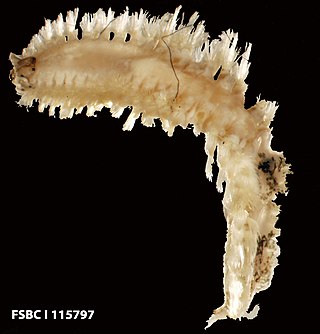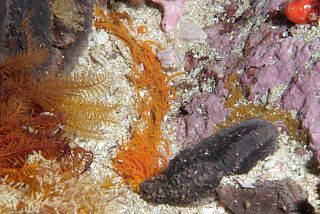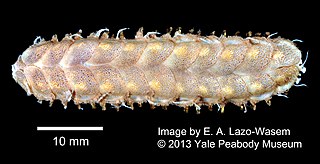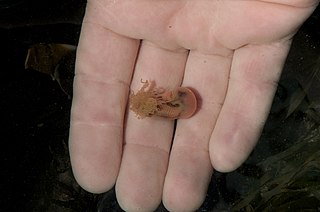
The genus Glycera is a group of polychaetes commonly known as bloodworms. They are typically found on the bottom of shallow marine waters, and some species can grow up to 35 cm (14 in) in length.

Nereis is a genus of polychaete worms in the family Nereididae. It comprises many species, most of which are marine. Nereis possess setae and parapodia for locomotion and gas exchange. They may have two types of setae, which are found on the parapodia. Acicular setae provide support. Locomotor setae are for crawling, and are the bristles that are visible on the exterior of the Polychaeta. They are cylindrical in shape, found not only in sandy areas, and they are adapted to burrow. They often cling to seagrass (posidonia) or other grass on rocks and sometimes gather in large groups.

Nephtys is a genus of marine catworms. Some species are halotolerant to a degree in that they can survive in estuaries and estuarine lagoons down to a salinity of 20 psu.

Harmothoe is a genus of marine Polychaete worms belonging to the family Polynoidae. Species of Harmothoe are found world-wide to depths of at least 5,000 m but are more common in shallower water.

Diopatra is a genus of polychaete worms in the family Onuphidae.

Amphinomidae, also known as the bristle worms or sea mice, are a family of marine polychaetes, many species of which bear chaetae mineralized with carbonate. The best-known amphinomids are the fireworms, which can cause great pain if their toxin-coated chaetae are touched or trodden on. Their relationship to other polychaete groups is somewhat poorly resolved.

Cirriformia is a genus of marine polychaete worms in the family Cirratulidae.

Eulalia is a genus of polychaete worms.

Syllidae, commonly known as the necklace worms, is a family of small to medium-sized polychaete worms. Syllids are distinguished from other polychaetes by the presence of a muscular region of the anterior digestive tract known as the proventricle.

Lepidasthenia is a genus of marine Polychaete worms belonging to the family Polynoidae. Species of Lepidasthenia are found worldwide to depths of about 1200 m but are more common in shallower water.

Lepidonotus is a genus of marine annelids in the family Polynoidae. The genus occurs globally and includes 80 species, usually found in shallow waters down to about 80 metres.
Aglaophamus is a genus of free-burrowing nephtyid worms.

Naineris is a genus of polychaete annelids belonging to the family Orbiniidae. It was first described by Henri Marie Ducrotay de Blainville in 1828. The type species is Nais quadricuspida Fabricius, 1780, currently accepted as Naineris quadricuspida. The genus has cosmopolitan distribution.
Marphysa is a genus of annelids belonging to the family Eunicidae.

Thelepus is a genus of polychaetes belonging to the family Terebellidae.
Cirratulus is a genus of annelids belonging to the family Cirratulidae.

Odontosyllis is a genus of annelids belonging to the family Syllidae.
Linopherus is a genus of polychaetes belonging to the family Amphinomidae.
Lumbrineris is a genus of polychaetes belonging to the family Lumbrineridae.














